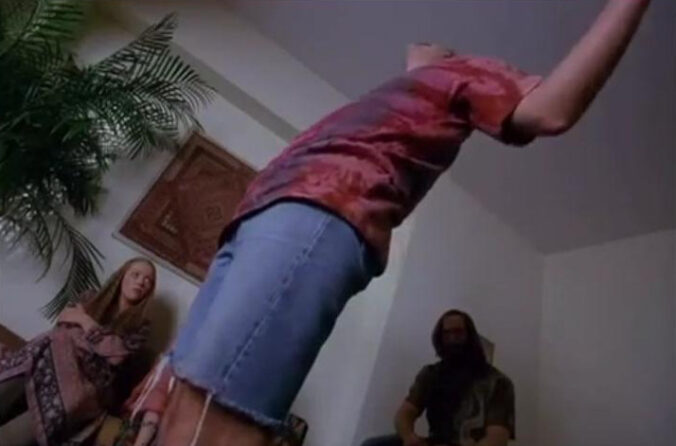Affordances are, for cognitive scientist John Vervaeke, the primary features of our perceptual salience landscape. The overlap between the salient landscape and McLuhan’s inner landscape are striking. Whatever is salient to us in our environment comes to our attention by proposing some interaction or participation with it (i.e. involvement for McLuhan). For the English professor McLuhan, steeped in art criticism, it is the deviation between the interior landscape and the material environment which he found of particular salience—particularly as it this gap presented itself as an abysmal, in-salient void to nearly everyone else.
After James Gibson coined the term affordance (he also coined the term percept in the ’50s, a term used by McLuhan in counterpoint to concept) the handle was taken up by product designers and HCI (human computer interaction) theorists as a means of creating easy-to-use commercial products whose usage was self-explanatory. Product designers and user-interface people are today’s “ad men.” They design the Apple Macintosh to look current and hip today—and obsolete and clunky next week. Just as McLuhan analyzed ads in the ’40s and ’50s, today he’d no doubt be analyzing their programming of our physical environment itself (of which we are content) by revealing the intentions of how they afford us some possibilities while withholding others.
The handles and buttons and motions of any contemporary technological device are the rear-view mirror environment of familiar old-ways, now simulated digitally. And the black-boxing of technology with closed source code, patented designs, and the lack of accessible screws or means of self-service/3rd party repair are just as important as being not afforded by design.
Where Vervaeke (at least—I can’t speak for other innovators on Gibson) lags behind McLuhan is in explicitly differentiating between these artistically, humanly designed illusory affordances of media content, and all the real affordances which are possible with understanding of the medium itself. This is hardly his fault—it’s a universal state to anyone not utterly-alienated from society at large. Just about everyone functional believes in the corporate pop-cultural narrative about computers, ignores Richard Stallman, and is thus stuck in Steve Job’s sand-box hallucination. The intellectual high-ground in this sandbox is stuck at the local-maxima of the Shannon Weaver communication model where abstract propositions, signs, and symbols fight against noise and the thermodynamic metaphor of entropy imported into information theory and the language of general/complex systems. It is certainly a rich “domain”, but far short of embodied relation to the contemporary material world. The end-result is invariably the projection of abstract systems onto the dynamics of the world. These run the gamut from formal models of axiomatic propositions to complexes such as Wheeler’s “it from bit” fractalnoid speculations on information-as-substance.
Without relation to the material world which is afforded by screwdrivers, soldering irons, and plenty of experience with setting up, troubleshooting, and hacking at technology, one inevitably falls into easily-afforded surface-level content of fictions as mental abstractions, developing the salience landscape deeper into the socially-constructed imaginary rather than the actual environment. The self, as embodied relation to the world, becomes, then, sutured into non-materiality, heigthening the plausibility of information as substance, like a new skin for the old wines of geist and ether and chi.
Someone enchanted by film, with true understanding of the medium itself, can become a film director. Someone without that study of the media becomes, instead, a LARPer, or glamorous idol, or other aesthetic enthusiast for the content. To the former the world affords cameras, microphones, and editing suites. To the latter the world affords costumes and make-up and fan merchandise. In music, it’s the difference between becoming a musician or becoming a life-long listener or fan. This same dichotomy plays out with technology leaders and post-human/cyberpunk content creators of a Gnostic bent.
McLuhan’s delicate handling of the term artist to describe those working with the material world as their medium made clear in the distinction. It is precisely their, as we say today, “world-building” capacity over the content-consumer which places them in a different relative time. The artist lives in the present by the penetrating perception of potential which their cultivated salience-landscapes affords to their will. It is the leading edge: unpredictable because unprecedented. The masses of “somnambulists,” enchanted by the artists designs, are met where they are at the surface-level of appearances, not compelled to dig any deeper. They are controllable because predictable, and predictable because living to well-established patterns of behaviour/relation to their environment: hence they live in the past.
McLuhan’s electric follow-up to the typographical The Mechanical Bride, released 20 years later, was called Culture is our Business. As the ramp toward participational knowing steepens even further away from propositions, perhaps a contemporary analyses of power through the programmed affordances of our contemporary material environment might be called Your Wish is Our Command Line?

Great piece, the product designers will need to consider ramifications of ad infinitum ramifications in order to properly maintain their Art.
Interval as/at figure essentially (hint: it’s always new ground, old cliche is new archetype)